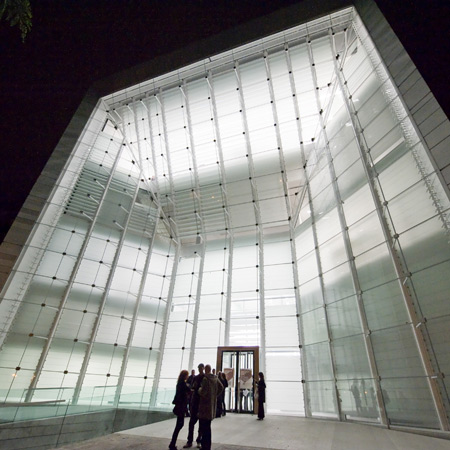The Museion in Bolzano, Italy, is a new museum of modern and contemporary art designed by Berlin-based architects Krüger Schuberth Vandreike.
The five floors of the museum include exhibition and events areas, educational workshops and a library. In addition, there is an atelier house adjoining the museum which will host artists in residence.
The museum will open its new building on 24th May with the inaugural exhibition Peripheral vision and collective body.
The following information is from Krüger Schuberth Vandreike:
--
MUSEION OPEN
On 24th May 2008 the new Museion, museum of modern and contemporary art in Bolzano (South Tyrol, Italy) is to open its new building designed by the Berlin architects KSV Krüger Schuberth Vandreike and commissioned by the Autonomous Province of Bolzano.
The new building corresponds to a redefinition of the entire Museion project: as an institution, Museion has been managed since 2006 by a foundation of which the Province of Bolzano and the Museion Association are part and, in 2007, Corinne Diserens was appointed as new director.
Museion derives its strength and driving force from its location, South Tyrol, an atypical and multicultural region with a strong European outlook, which will, this year, also be hosting the European Biennial for Contemporary Art Manifesta 7. Instead of a simple container of artworks, it will be an international laboratory for research with an interdisciplinary focus: this is the museum that is being born. Museion sets at the center of its development a strong activation of the collection that will live in a relationship with temporary exhibitions. It will also stimulate the collaboration with artists through production and artists’ residencies.
Museion’s project is reflected in its architecture. The cubic form of the building is visually striking, with the transparent front facades offering a dialogue with the city. The physical and symbolical tie between the historical center and the new city is completed by the two parallel and oscillating curves of the bridge, an integral part of the project. The building’s interior spaces are fluid: the five levels of museum activity — exhibition and events areas, educational workshops, library — aren’t rigidly separated from one another, but are intimately interconnected.
Adjoining the museum is an atelier house to host artists. At night the museum will offer passers-by a stunning view when the facades will act as screens for the projection of artworks especially commissioned by Museion.
The opening show: ‘Peripheral vision and collective body’
The activation of the collection finds its full expression in the opening show “Peripheral vision and collective body.” The exhibition, conceived as an exceptional event for the opening, will gather numerous works from the collection, including new acquisitions and important long-term loans from private collectors, as well as loans from national and international museums.
Peripheral vision and collective body discusses the question of the collective bodies in contemporary visual art considering the tight relationship with architecture and performance (dance in particular). Looking at how recent artistic proposals have been informed by the American avant-gardes from the post WW II period which themselves had activated some experimentation from the German, Polish and Russian milieu of the early XX Century. The exhibition will bring together a selection of works, including film, performance, documents and texts from Meyerhold to contemporary art, which will explore the creation and the use of ‘the collective body’ as a critical strategy to question the legacy of our recent history.
This path takes as a starting point the notion of “peripheral vision” as opposed to central vision, that is to say the ability to see objects and movement outside of the direct line of vision and explores diverse ways of challenging single vs public experiences of spaces.
‘Peripheral vision and collective body’ will run from 24 May to 21 September 2008. There will be an accompanying program of events, performances, films and talks. The exhibition catalogue will be co-published with Hatje Cantz in German, Italian and English editions.

